Search of Graph
- There are two kinds of way to search graph
- DFS and BFS
- DFS
- Depth First Search Algorithm
- Search graph as deeply and many as it can
- It uses Stack
- BFS
- Breadth First Search Algorithm
- Search graph as broadly as it can
- It uses Queue
- When all edges' weight is 1
- it becomes the algorithm for getting shortest distance
- Purpose of graph search (DFS, BFS)
- To visit all vertices once
- Algorithm of DFS
- by using stack, it goes as much as it can
- when there is no way to go, it goes back to a previous vertex
- example)
- first, to check if this vertex is already visited
- it's good to make array for remembering the vertex number it visited.
- i ........... 1 2 3 4 5 6
- check[i] 1 0 0 0 0 0
- it is a first state. start point is 1 and it is not moving yet
- when all of check array's value have value of 1, this algorithm will be over.
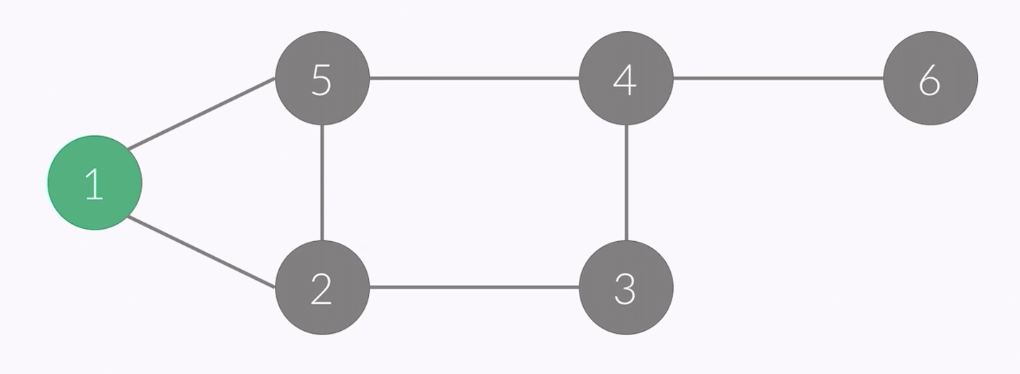
- when graph's state is like this, it can move any direction (2 or 5).
- but in this case, we will make this go to smaller number first.
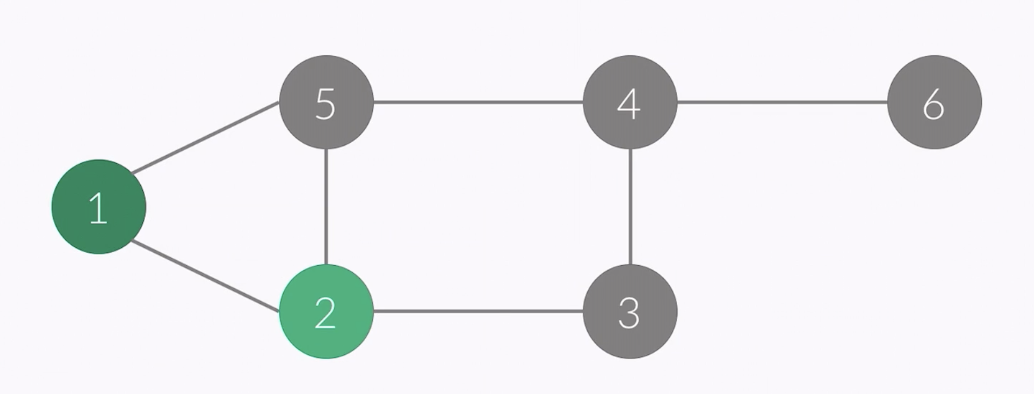
- so it went to number 2
- and array will be like
- i ........... 1 2 3 4 5 6
- check[i] 1 1 0 0 0 0
- vertex of this point : 2
- order : 1 2
- stack : 1 2
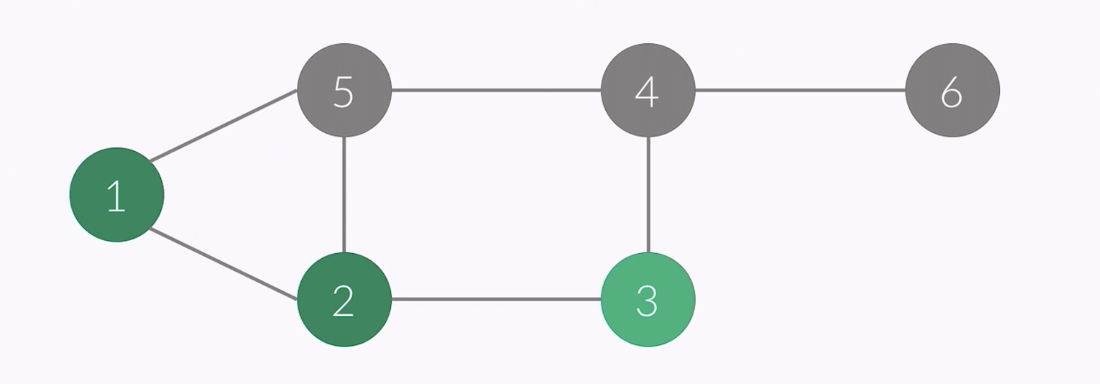
- vertex of this point : 3
- i ........... 1 2 3 4 5 6
- check[i] 1 1 1 0 0 0
- order : 1 2 3
- stack : 1 2 3

- vertex of this point : 4
- i ........... 1 2 3 4 5 6
- check[i] 1 1 1 1 0 0
- order : 1 2 3 4
- stack : 1 2 3 4
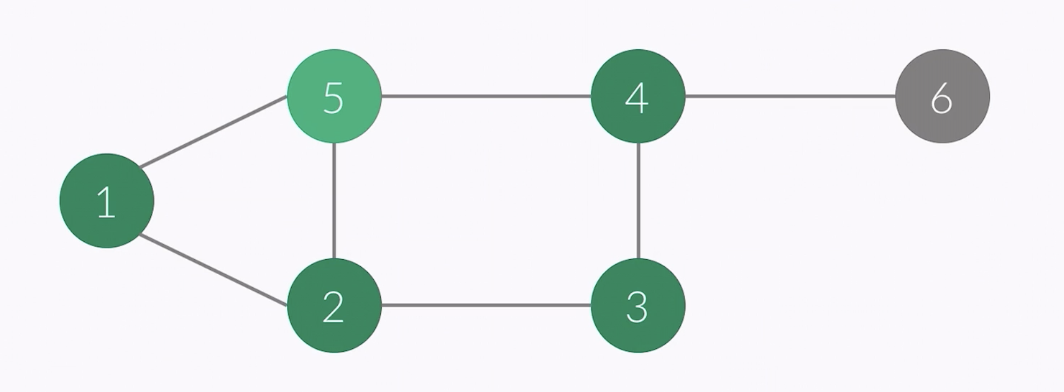
- vertex of this point : 5
- i ........... 1 2 3 4 5 6
- check[i] 1 1 1 1 1 0
- order : 1 2 3 4 5
- stack : 1 2 3 4 5
- in this case, it has to go back to go to vertex 6
- by using stack, it can trace the number of vertices it has stopped by at
- after popping stack it will go to vertex number 4
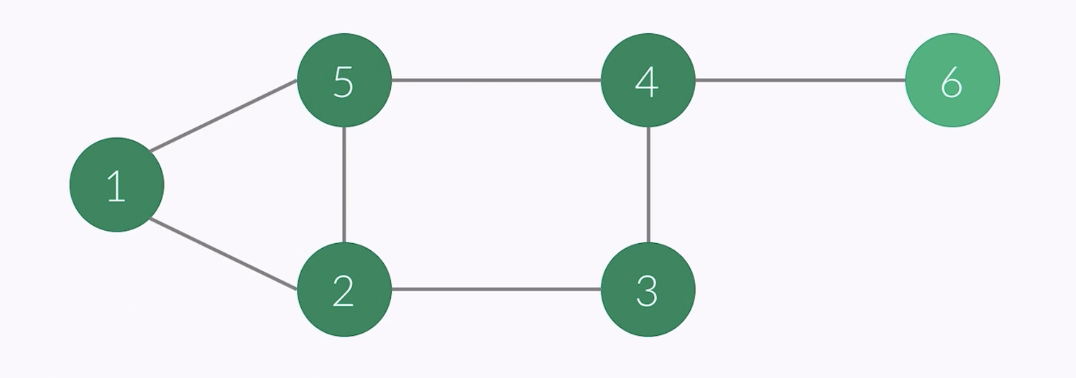
- vertex of this point : 5
- i ........... 1 2 3 4 5 6
- check[i] 1 1 1 1 1 0
- order : 1 2 3 4 5 6
- stack : 1 2 3 4 6
- it's all over now
- once it over, people can know it's over but
- stack goes popping one by one
- after stack : 1 2 3 4
- it can know that there is no vertex to go.
- it is judged by checking if array 'check[i]'s value is 1 or 0
- only if the value is 0, we can go to that number of vertex
- it should pop the stack out
- after stack : 1 2 3
- after stack : 1 2
- after stack : 1
- after stack : empty
- implement of DFS with Adjecency Matrix
- time complexity = V * O(V) -> O(V^2)
void dfs(int x) { // implemented recursively
check[x] = true;
printf("%d ", x);
for (int i=1; i<=n; i++) {
if (a[x][i] == 1 && check[i] == false) {
dfs(i);
}
}
}
- implement of DFS with Adjacency List
- time complexity = O(V + E)
void dfs(int x) {
check[x] = true;
printf("%d ", x);
for (int i=0; i<a[x].size(); i++) {
int y = a[x][i];
if (check[y] == false) {
dfs(y);
}
}
}
```
- Algorithm of BFS
- by using queue, it puts all the vertices which it can go to into queue
- when it puts vertices into queue, it should check that number of vertex is in queue
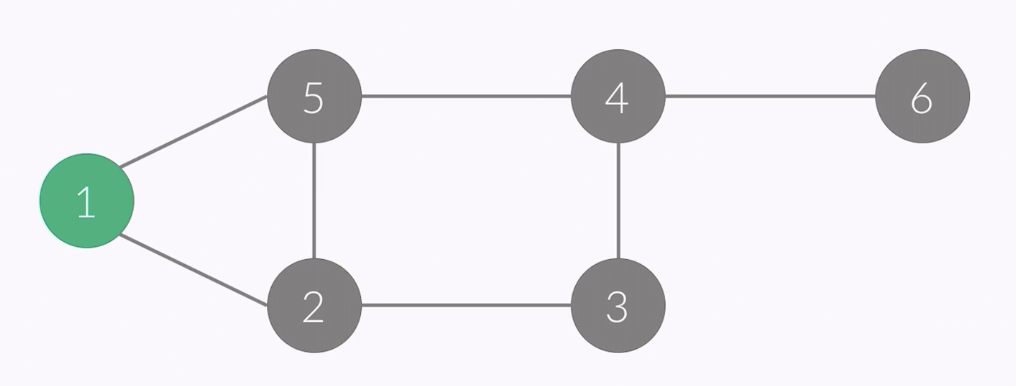
- vertex of this point : 1
- i ........... 1 2 3 4 5 6
- check[i] 1 0 0 0 0 0
- order : 1
- queue : 1
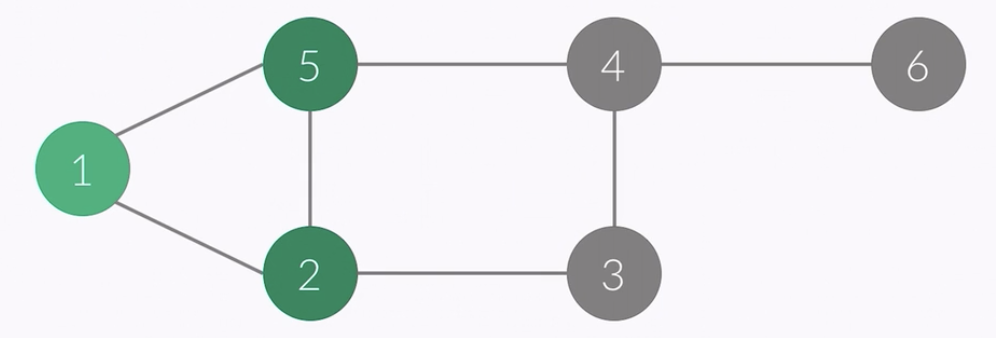
- vertex of this point : 1
- i ........... 1 2 3 4 5 6
- check[i] 1 1 0 0 1 0
- order : 1 2 5
- queue : 1 2 5
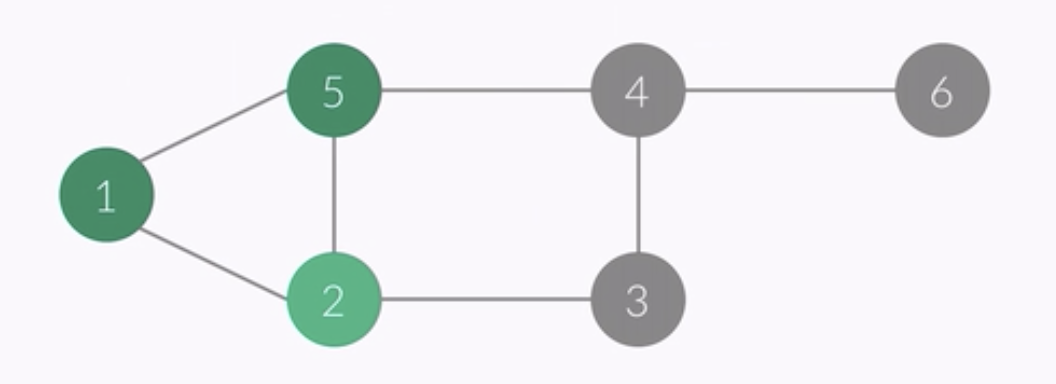
- vertex of this point : 2
- i ........... 1 2 3 4 5 6
- check[i] 1 1 0 0 1 0
- order : 1 2 5
- queue : 2 5
- in this case, it can't go to 5 because 5 has been already checked at this point.
- so it saves only vertex number 3
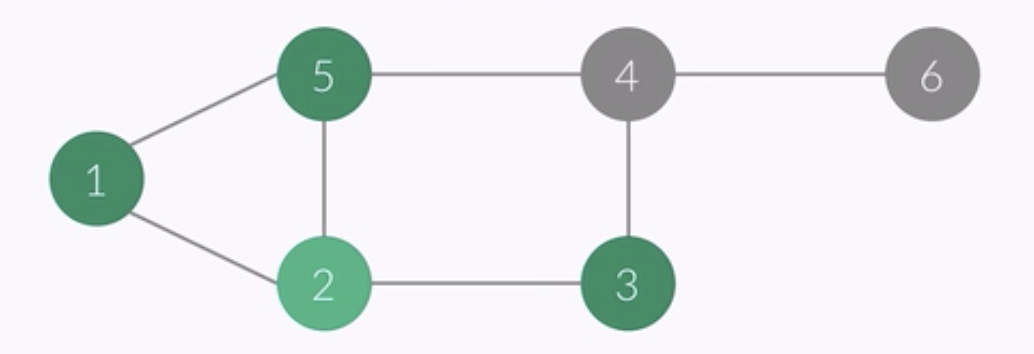
- vertex of this point : 2
- i ........... 1 2 3 4 5 6
- check[i] 1 1 1 0 1 0
- order : 1 2 5 3
- queue : 2 5 3
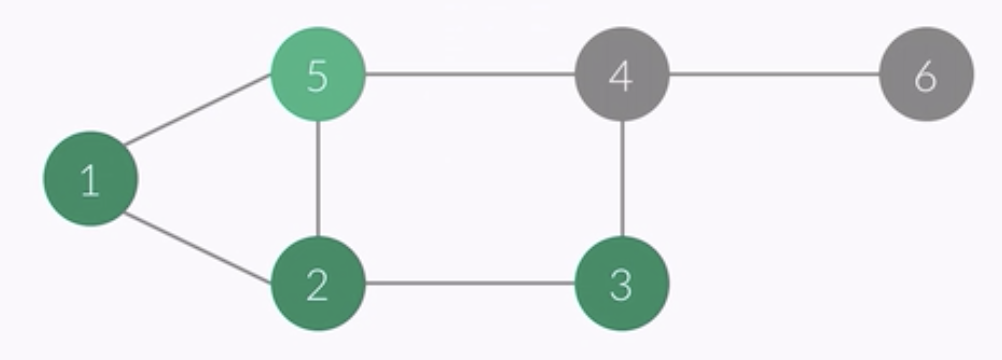
- vertex of this point : 5
- i ........... 1 2 3 4 5 6
- check[i] 1 1 1 0 1 0
- order : 1 2 5 3
- queue : 5 3
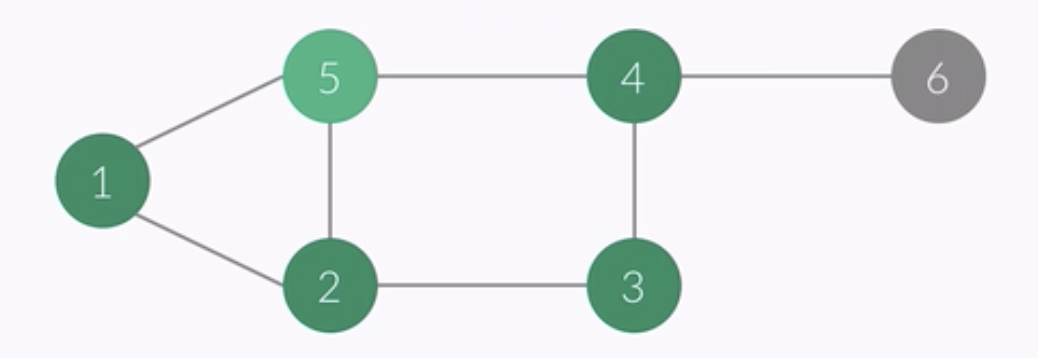
- vertex of this point : 5
- i ........... 1 2 3 4 5 6
- check[i] 1 1 1 1 1 0
- order : 1 2 5 3 4
- queue : 5 3 4
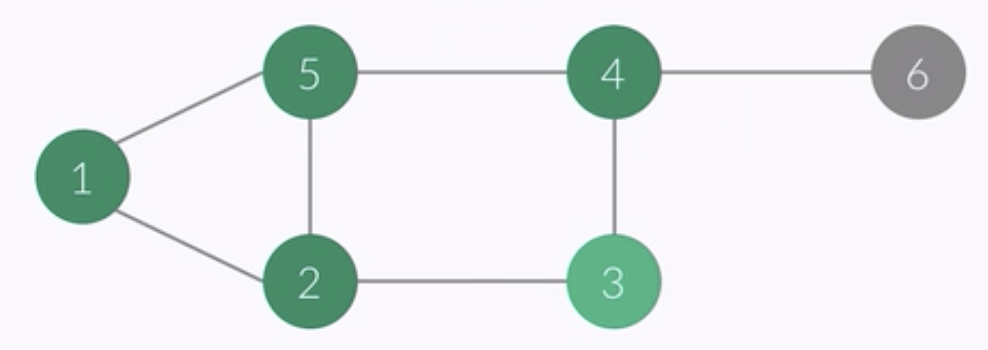
- vertex of this point : 3
- i ........... 1 2 3 4 5 6
- check[i] 1 1 1 1 1 0
- order : 1 2 5 3 4
- queue : 3 4
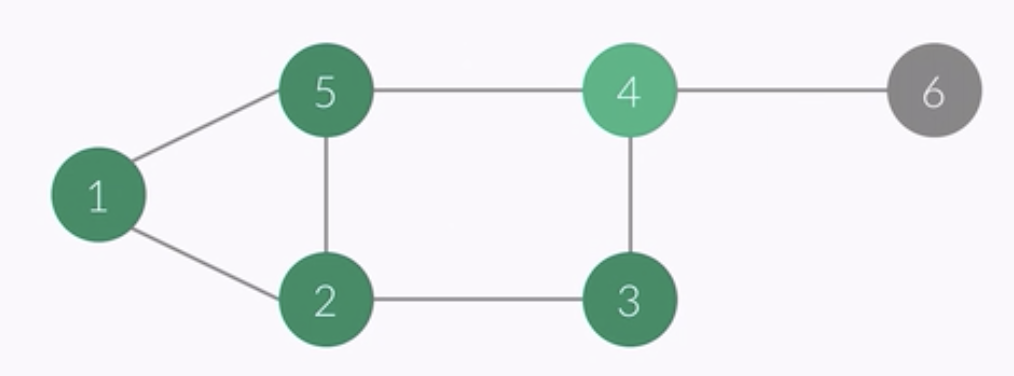
- vertex of this point : 4
- i ........... 1 2 3 4 5 6
- check[i] 1 1 1 1 1 0
- order : 1 2 5 3 4
- queue : 4
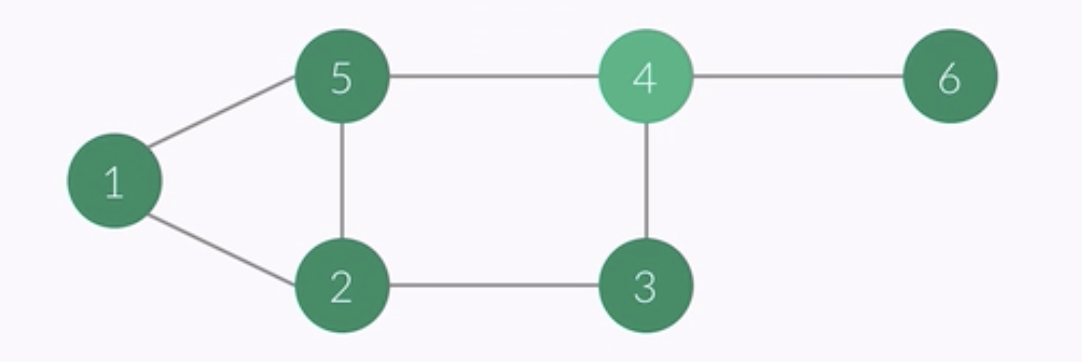
- vertex of this point : 4
- i ........... 1 2 3 4 5 6
- check[i] 1 1 1 1 1 1
- order : 1 2 5 3 4 6
- queue : 4 6

- vertex of this point : 6
- i ........... 1 2 3 4 5 6
- check[i] 1 1 1 1 1 1
- order : 1 2 5 3 4 6
- queue : 6
- implement of BFS with Adjacency Matrix queue<int> q;
check[1] = true; q.push(1);
while(!q.empty()) {
int x = q.front(); q.pop();
printf("%d ", x);
for (int i=1; i<=n; i++) { // it's really similar to DFS, but DFS is implemented by recursive function
if (a[x][i] == 1 && check[i] == false) {
check[i] = true;
q.push(i);
}
}
}
- implemented of BFS with Adjacency List
queue<int> q;
check[1] = true; q.push(1);
while (!q.empty()) {
int x = q.front(); q.pop();
printf("%d ", x);
for (int i=0; i<a[x].size(); i++) {
int y = a[x][i];
if (check[y] == false) {
check[y] = true; q.push(y);
}
}
}
```
Problem implementing DFS and BFS
import java.io.BufferedReader;
import java.io.IOException;
import java.io.InputStreamReader;
import java.util.ArrayList;
import java.util.Collections;
import java.util.LinkedList;
import java.util.StringTokenizer;
public class Main {
static boolean[] checkList;
static int numOfVisitedVertices;
static StringBuffer sb = new StringBuffer();
public static void dfs(ArrayList<Integer>[] adjacentList, int startVertexNum, int numOfVertices){
int currentVertexNum;
for(int i=0; i<adjacentList[startVertexNum].size(); i++) {
if(!checkList[adjacentList[startVertexNum].get(i)]) {
currentVertexNum = adjacentList[startVertexNum].get(i);
sb.append(currentVertexNum + " ");
checkList[currentVertexNum] = true;
numOfVisitedVertices++;
dfs(adjacentList, currentVertexNum, numOfVertices);
}
}
}
public static void bfs(ArrayList<Integer>[] adjacentList, int startVertexNum, int numOfVertices){
LinkedList<Integer> queue = new LinkedList();
queue.push(startVertexNum);
while(!queue.isEmpty()){
int currentVertexNum = queue.peekFirst();
for(int i=0; i<adjacentList[currentVertexNum].size(); i++) {
int currentEdgeNum = adjacentList[currentVertexNum].get(i);
if(!checkList[currentEdgeNum]) {
queue.add(currentEdgeNum);
checkList[currentEdgeNum] = true;
}
}
sb.append(queue.poll() + " ");
}
}
public static void main(String args[]) throws IOException {
BufferedReader br = new BufferedReader(new InputStreamReader(System.in));
StringTokenizer st = new StringTokenizer(br.readLine());
int numOfVertices = Integer.parseInt(st.nextToken());
int numOfEdges = Integer.parseInt(st.nextToken());
int startVertex = Integer.parseInt(st.nextToken());
ArrayList<Integer>[] adjacentList = new ArrayList[numOfVertices + 1];
for(int i=0; i<numOfEdges; i++){
st = new StringTokenizer(br.readLine());
int vNum = Integer.parseInt(st.nextToken());
int eNum = Integer.parseInt(st.nextToken());
if(adjacentList[vNum] == null) adjacentList[vNum] = new ArrayList();
if(adjacentList[eNum] == null) adjacentList[eNum] = new ArrayList();
adjacentList[vNum].add(eNum);
adjacentList[eNum].add(vNum);
}
for(int i=1; i<=numOfVertices; i++)
if(adjacentList[i] != null)
Collections.sort(adjacentList[i]);
checkList = new boolean[numOfVertices + 1];
checkList[startVertex] = true;
numOfVisitedVertices = 1;
sb.append(startVertex + " ");
dfs(adjacentList, startVertex, numOfVertices);
sb.append("\n");
checkList = new boolean[numOfVertices + 1];
checkList[startVertex] = true;
bfs(adjacentList, startVertex, numOfVertices);
System.out.print(sb);
}
}

















Earning your HCIP-Security V4.0 (H12-725_V4.0) certification is a major milestone in your cybersecurity career, and the right preparation tools can make all the difference. High-quality exam dumps provide a strategic advantage by offering real exam-like questions and verified answers that align with Huawei’s latest certification standards. These dumps cover critical topics such as firewall policies, intrusion prevention, VPN technologies, and security risk management, ensuring you’re fully prepared for every section of the test. With structured practice, you can confidently approach the exam, knowing you’ve mastered the key concepts needed to succeed.
https://www.dumpswrap.com/product-detail/h12-725_v4-0.html